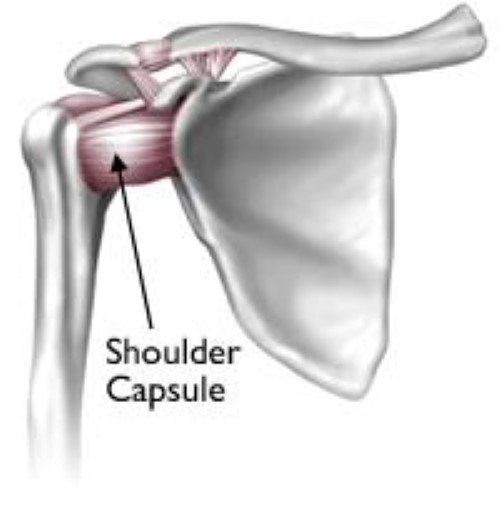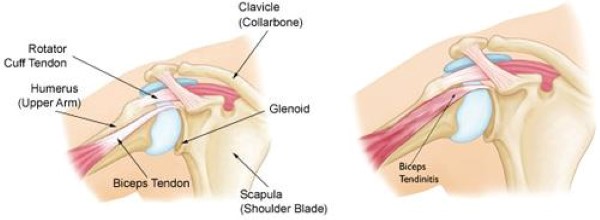Although throwing injuries in the shoulder most commonly occur in baseball pitchers, they can be seen in any athlete who participates in sports that require repetitive overhand motions, such as volleyball, tennis, and some track and field events.
Your shoulder is a ball-and-socket joint made up of three bones: your upper arm bone (humerus), your shoulder blade (scapula), and your collarbone (clavicle).
The head of your upper arm bone fits into a rounded socket in your shoulder blade. This socket is called the glenoid. Surrounding the outside edge of the glenoid is a rim of strong, fibrous tissue called the labrum. The labrum helps to deepen the socket and stabilize the shoulder joint. It also serves as an attachment point for many of the ligaments of the shoulder, as well as one of the tendons from the biceps muscle in the arm.
Strong connective tissue, called the shoulder capsule, is the ligament system of the shoulder and keeps the head of the upper arm bone centered in the glenoid socket. This tissue covers the shoulder joint and attaches the upper end of the arm bone to the shoulder blade.


Your shoulder also relies on strong tendons and muscles to keep your shoulder stable. Some of these muscles are called the rotator cuff. The rotator cuff is made up of four muscles that come together as tendons to form a covering or cuff of tissue around the head of the humerus.
The biceps muscle in the upper arm has two tendons that attach it to the shoulder blade. The long head attaches to the top of the shoulder socket (glenoid). The short head attaches to a bump on the shoulder blade called the coracoid process. These attachments help to center the humeral head in the glenoid socket.

In addition to the ligaments and rotator cuff, muscles in the upper back play an important role in keeping the shoulder stable. These muscles include the trapezius, levator scapulae, rhomboids, and serratus anterior, and they are referred to as the scapular stabilizers. They control the scapula and clavicle bones — called the shoulder girdle — which functions as the foundation for the shoulder joint.

When athletes throw repeatedly at high speed, significant stresses are placed on the anatomical structures that keep the humeral head centered in the glenoid socket.

Of the five phases that make up the pitching motion, the late cocking and follow-through phases place the greatest forces on the shoulder.
When one structure — such as the ligament system — becomes weakened due to repetitive stresses, other structures must handle the overload. As a result, a wide range of shoulder injuries can occur in the throwing athlete.
The rotator cuff and labrum are the shoulder structures most vulnerable to throwing injuries.
In a SLAP injury, the top (superior) part of the labrum is injured. This top area is also where the long head of the biceps tendon attaches to the labrum. A SLAP tear occurs both in front (anterior) and in back (posterior) of this attachment point.
Typical symptoms are a catching or locking sensation, and pain with certain shoulder movements. Pain deep within the shoulder or with certain arm positions is also common.

Repetitive throwing can inflame and irritate the upper biceps tendon. This is called biceps tendinitis. Pain in the front of the shoulder and weakness are common symptoms of biceps tendinitis.
Occasionally, the damage to the tendon caused by tendinitis can result in a tear. A torn biceps tendon may cause a sudden, sharp pain in the upper arm. Some people will hear a popping or snapping noise when the tendon tears.

When a muscle or tendon is overworked, it can become inflamed. The rotator cuff is frequently irritated in throwers, resulting in tendinitis.
Early symptoms include pain that radiates from the front of the shoulder to the side of the arm. Pain may be present during throwing, other activities, and at rest. As the problem progresses, pain may occur at night, and the athlete may experience a loss of strength and motion.
Rotator cuff tears often begin by fraying. As the damage worsens, the tendon can tear. When one or more of the rotator cuff tendons is torn, the tendon no longer fully attaches to the head of the humerus. Most tears in throwing athletes occur in the supraspinatus tendon.

During the cocking phase of an overhand throw, the rotator cuff tendons at the back of the shoulder can get pinched between the humeral head and the glenoid. This is called internal impingement and may result in a partial tearing of the rotator cuff tendon. Internal impingement may also damage the labrum, causing part of it to peel off from the glenoid.
Internal impingement may be due to some looseness in the structures at the front of the joint, as well as tightness in the back of the shoulder.


Shoulder instability occurs when the head of the humerus slips out of the shoulder socket (dislocation). When the shoulder is loose and moves out of place repeatedly, it is called chronic shoulder instability.
In throwers, instability develops gradually over years from repetitive throwing that stretches the ligaments and creates increased laxity (looseness). If the rotator cuff structures are not able to control the laxity, then the shoulder will slip slightly off-center (subluxation) during the throwing motion.
Pain and loss of throwing velocity will be the initial symptoms, rather than a sensation of the shoulder “slipping out of place.” Occasionally, the thrower may feel the arm “go dead.” A common term for instability many years ago was “dead arm syndrome.”
As mentioned above, the extreme external rotation required to throw at high speeds typically causes the ligaments at the front of the shoulder to stretch and loosen. A natural and common result is that the soft tissues in the back of the shoulder tighten, leading to loss of internal rotation.
This loss of internal rotation puts throwers at greater risk for labral and rotator cuff tears.
Proper movement and rotation of the scapula over the chest wall is important during the throwing motion. The scapula (shoulder blade) connects to only one other bone: the clavicle. As a result, the scapula relies on several muscles in the upper back to keep it in position to support healthy shoulder movement.
During throwing, repetitive use of scapular muscles creates changes in the muscles that affect the position of the scapula and increase the risk of shoulder injury.
Scapular rotation dysfunction is characterized by drooping of the affected shoulder. The most common symptom is pain at the front of the shoulder, near the collarbone.
In many throwing athletes with SICK scapula, the chest muscles tighten in response to changes in the upper back muscles. Lifting weights and chest strengthening exercises can aggravate this condition.
The medical history portion of the initial doctor visit includes discussion about your general medical health, symptoms and when they first began, and the nature and frequency of athletic participation
During the physical examination, Dr. Craythorne will check the range of motion, strength, and stability of your shoulder. He or she may perform specific tests by placing your arm in different positions to reproduce your symptoms.
The results of these tests help the doctor decide if additional testing or imaging of the shoulder is necessary.
Dr. Craythorne may order tests to confirm your diagnosis and identify any associated problems.
X-rays. This imaging test creates clear pictures of dense structures, like bone. X-rays will show any problems within the bones of your shoulder, such as arthritis or fractures.
Magnetic resonance imaging (MRI). This imaging study shows better images of soft tissues. It may help Dr. Craythorne identify injuries to the labrum, ligaments, and tendons surrounding your shoulder joint.
Computed tomography (CT) scan. This test combines x-rays with computer technology to produce a very detailed view of the bones in the shoulder area.
Ultrasound. Real time images of muscles, tendons, ligaments, joints, and soft tissues can be produced using ultrasound. This test is typically used to diagnose rotator cuff tears in individuals who are not able to have MRI scans.
Left untreated, throwing injuries in the shoulder can become complicated conditions.
In many cases, the initial treatment for a throwing injury in the shoulder is nonsurgical. Treatment options may include:
Dr. Craythorne may recommend surgery based on your history, physical examination, and imaging studies, or if your symptoms are not relieved by nonsurgical treatment.
The type of surgery performed will depend on several factors, such as your injury, age, and anatomy. Your orthopaedic surgeon will discuss with you the best procedure to meet your individual health needs.
Arthroscopy. Most throwing injuries can be treated with arthroscopic surgery. During arthroscopy, the surgeon inserts a small camera, called an arthroscope, into the shoulder joint. The camera displays pictures on a television screen, and the surgeon uses these images to guide miniature surgical instruments.
Because the arthroscope and surgical instruments are thin, the surgeon can use very small incisions (cuts), rather than the larger incision needed for standard, open surgery.
During arthroscopy, your doctor can repair damage to soft tissues, such as the labrum, ligaments, or rotator cuff.
Open surgery. A traditional open surgical incision (several centimeters long) is often required if the injury is large or complex.
Rehabilitation. After surgery, the repair needs to be protected while the injury heals. To keep your arm from moving, you will most likely use a sling for for a short period of time. How long you require a sling depends upon the severity of your injury.
As soon as your comfort allows, Dr. Craythorne may remove the sling to begin a physical therapy program.
In general, a therapy program focuses first on flexibility. Gentle stretches will improve your range of motion and prevent stiffness in your shoulder. As healing progresses, exercises to strengthen the shoulder muscles and the rotator cuff will gradually be added to your program. This typically occurs 4 to 6 weeks after surgery.
Dr. Craythorne will discuss with you when it is safe to return to sports activity. If your goal is to return to overhead sports activities, Dr. Craythorne will direct a therapy program that includes a gradual return to throwing.
It typically takes 2 to 4 months to achieve complete relief of pain, but it may take up to a year to return to your sports activities.
In recent years, there has been a great deal of attention on preventing throwing injuries of the shoulder.
Proper conditioning, technique, and recovery time can help to prevent throwing injuries. Throwers should strive to maintain good shoulder girdle function with proper stretches and upper back and torso strengthening.
In the case of younger athletes, pitching guidelines regarding number of pitches per game and week, as well as type of pitches thrown, have been developed to protect children from injury.
508 S Habana Ave, Suite 335
Tampa Fl 33609
Privacy Policy
Copyright 2020 @ SRL Group. All rights reserved.
